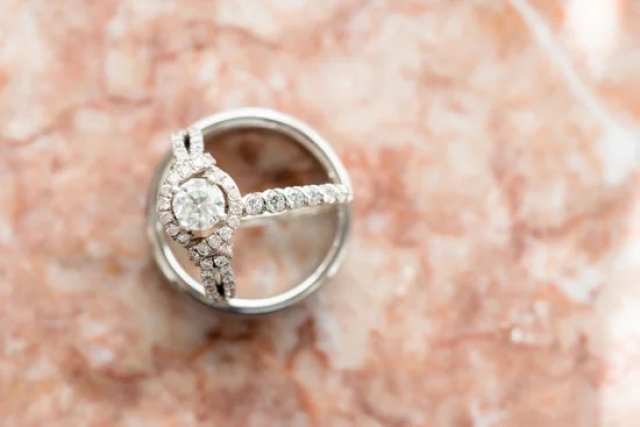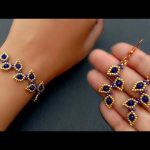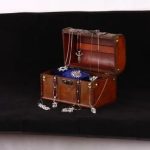The use of woven jewelry material dates all the way back to ancient history. In both Egypt and Greece, intricate jewelry designs made from woven cord were in use by the wealthy to show off their social standing.
Not only was it a beautiful and fashionable accent for their clothing, but it was also used as a form of adornment to represent an individual’s economic power and status. This tradition has carried over into today’s world, where we are now using a variety of materials such as silk, hemp, nylon, and thread to create one-of-a-kind pieces that are perfect for any occasion.
Throughout history, weaving and knotting have been popular techniques used to make everything from clothing items to ornaments for religious ceremonies. These days we no longer just rely on these same traditional methods when making woven jewelry items; instead there is a wide array of materials out there available for us to use in order to create something unique and special.
For instance, instead of using standard cotton thread or hemp you could try using fabric yarns or leather strips; this will open up more possibilities in terms of color combinations and textures. Other materials like metal cords or plastic tubes can also be used depending on the desired outcome and overall design.
Using different weaving patterns can completely dramatically change the look of your piece; from tight rope knots with multiple strands interwoven together to complex knot shapes that require numerous small loops and ties – the possibilities really are endless. One great thing about this kind of crafting is that your options aren’t limited by size either as you could even opt for creating earrings, necklaces or bracelets – all with a bit of imagination woven into each stitch.
With so many things you can do with woven jewelry material it’s easy to see why it remains such an popular craft centuries later.
History and Origins of Woven Jewelry Materials
The origin of woven jewelry material can be dated back centuries ago. It is thought to have first been used in ancient cultures such as that of the Egyptians and Babylonians. Jewelry weaving was an important part of the people’s cultural identity, consisting of woven materials created from metal, leather and semi-precious stones.
The technique was passed down from one generation to the next, making it a treasured skill with immense customary meaning. Additionally, scholars note that this form of jewelry colored the music and literature scene with styles such as musical lute straps and hair ornaments known as pastoralis crafted out of these same materials.
Today, we see various different crafted jewels created from a multitude of woven materials. Hair accessories such as barrettes, earrings made out of natural rubber elastic cord and gemstone bracelets are all products typically associated with this art form demonstrating the vast variation in creative possibilities through this medium.
Many modern weavers also opt to infuse beads into their designs for extra flair rather than sticking solely to woven materials. These intricate pieces can then be found at farmers markets as well as boutiques offering unique artisanal items from around the world.
Jewelry weaving has obviously changed over the years but what makes it so remarkable is its ability to remain true to tradition while still evolving with time.
As imagined designs progress further into sophistication and technology offers greater access to an extensive selection of supplies in vibrant colours, sparks excitement among both new beginnings and craftsman who practice this centuries old craft today with an ever-growing populace appreciating their hard work and dedication to an art so deeply rich in history.
A Guide to Different Types of Woven Jewelry Materials
Woven jewelry has become a popular and accessible craft over the past few years. Crafting beautiful pieces using threads, yarns, wire, fabrics, even paper strips is a great way to create personal accessories. Weaving craft items can also be used to explore colour and texture combinations. There are several materials available to create different types of woven jewelry, with shades and textures ranging from light and delicate to strong and bold.
Thread and Yarn
Thread and yarn are the two most commonly used materials for making jewelry with weaving techniques. Both come in multiple colors, thicknesses, and weights. A good combination of thin threads or yarns gives an eclectic look as they vary in color and texture. As both materials have natural flexibility they can be woven in intricate patterns quite easily which makes them perfect for making bracelets, wrap rings or earrings with charm pendants.
Wire
Wire offers more rigidness compared with thread and yarn, thus it is ideal for creating sturdy pieces like necklaces or statement pieces like chokers.
Wires also come in various gauges that can range from the very thick 22 gauge (which is strong enough to support heavier pendants) down to thinner sizes such as 28-30 gauge which are much better suited for detailed weaving patterns such as those found on macrame necklaces sets or bracelets with precious beads along it’s length.
Fabrics
A unique material when crafting jewelry is fabrics which can give an altogether different aesthetic than traditional materials like wire or thread do. Fabrics like felt ribbons in bright colors offer an interesting way to bring texture into jewelry making projects while other more stiffened fabrics like pleather are attractive choices for layering around chokers or multi link necklaces sets for added stability that will accentuate the technique nicely too.
Care and Upkeep Tips for Woven Jewelry Materials
Woven jewelry materials, such as macramé, beadweaving and bead-knit, are an incredibly versatile type of jewelry material. However, they do require special care and attention if you want to keep them looking their best. Below are some tips on how to care for these delicate fabrics:
Storing Your Jewelry
The first tip for taking care of woven jewelry pieces is to store them properly. It is important that you store them separately from other jewelry items and away from direct sunlight or damp environments. In addition, they should be stored flat or hung up in order to avoid kinks or snags; this will help the fabric retain its shape for a longer period of time.
Cleaning Your Jewelry
To keep your woven jewelry looking like new over time, it is important to regularly clean it in a gentle manner. To do this, use a soft cloth and some mild soap solution. Do not rub too harshly; instead, gently pat the fabric down with the soapy cloth before rinsing it thoroughly with warm water. Once clean, allow the piece to air dry away from any direct sunlight or heat sources.
Repairing Worn Pieces
If particular areas of your jewelry item start becoming worn out due to a lot of wear and tear over time, then it’s worth getting a professional repair service that specializes in maintaining these materials. This is especially true for materials such as macramé which require intricate knot-tying techniques in order to restore damage.
A repair shop would also be able to replace any broken clasps or add beading decorations that have become loose over time. ; alternatively you may wish to purchase replacement components yourself if the task does not seem overly difficult according to your own skill level.
How to Choose the Right Woven Jewelry Material for Your Style
When it comes to making jewelry, selecting the right materials can go a long way to creating the perfect piece. With woven jewelry, there are a lot of different options when selecting materials for an affordable price. The material you select depends on what type of look and feel you are attempting to create with your jewelry piece.
The first thing to consider is if your woven jewelry will be made with metal fibers or synthetic fibers. Metal fibers blend well with any classic outfit and comes in various colors to choose from such as gold, silver, bronze, pewter and more. Metal fiber allows weavers to create tight-knit pieces that provide subtle texture and shine.
Synthetic fiber offers many options for bright colors and bold patterns that make the perfect statement piece. Depending on which type of look you’re going for either option can achieve this easily.
Another factor when choosing fiber material for woven jewelry is its malleability or strength. This determines if the piece has great flexibility that gives weavers freedom to experiment or maintains durability over time and wear and tear. Let’s look at some common weave materials:
- Nylon offers superior durability along with great flexibility allowing them to move freely under stress.
- Wool works best when used as an accent alongside other materials like cotton as wool is soft but not durable.
- Cotton offers good flexibility due to its softness but does increases pilling over time.
- Linen allows tight knitting capabilities giving it strength with plenty of room for subtle texture.
- Silk is praised for its luster and versatility while remaining relatively strong.
Fashion Trends featuring Woven Jewelry Materials
Fashion accessories featuring woven jewelry materials have become increasingly popular in both clothing and accessory pieces. Woven jewelry materials such as hemp, bamboo, jute, chenille, and sisal provide an appealing tactile look that adds texture to clothing and accessory designs. These natural woven items can be transformed into eye-catching pieces of jewelry that will add a unique touch to any outfit or ensemble.
Designs Featuring Woven Jewelry Materials
Woven jewelry materials offer many different design possibilities for fashion accessories. Weaving techniques such as double weaves, flat stitches, round forms, kumihimo braids, and finger weaving can all be used to create intricate and beautiful pieces of jewelry with a handcrafted feel. Additionally, these weaving techniques provide an opportunity to explore the creative potential of color blending through the use of different colors of yarn or thread in each piece.
For example, some designs feature two strands working together to form a colorful pattern or shape. In other cases different widths may be used to give the appearance of multiple fabric layers combined into one design.
Commonly Used Materials
Beading wire is often used with woven materials in order to add shape and structure to the design as well as durability when worn on the body. Commonly available in gold filled or sterling silver plating options, this material is often chosen due its resistance against tarnishing even after long wear times.
Other metals such as copper are also used in some designs due to their malleability which allows them to fit comfortably around wrists without binding uncomfortably while worn. Similarly nylon cord is another common material found in many jewelry designs due its softness which provides added comfort when worn around the neck or wrist areas over time while still offering durability when needed during wear times.
The Benefits Of Wearing Woven Jewelry Materials
Jewelry made from woven material offers several advantages over traditional metal and gemstone pieces due its versatility and aesthetic appeal. The natural texture created by weaving techniques gives each piece an individualized look that can easily be coordinated with most clothing styles both casual or professional while still demanding attention whenever it’s worn.
In addition, many designs incorporating woven materials are completely customizable meaning each item purchased can be tailored specifically for a purchaser’s taste or needs making many items one-of-a-kind designs that truly reflect their personality through fashion choices made day-to-day. This uniqueness captures people’s attention ultimately helping wearers show off their personal style with confidence wherever they go no matter what they’re wearing.
The Current Popularity Of Woven Jewelry Material Design Types
As more attention has been brought towards awareness for environmentally friendly materials used across all industries recently,certain types of brown hues found within these weave designs have taken hold within popular color palettes currently being discussed amongst fashion enthusiasts worldwide. With designers at major labels looking for new ways outside traditional metallic material frames,they’ve looked towards earthy tones seen within necklace or bracelet fabrics crafted from recycled plastic bottles as a statement entry item within their collections.
As global streetwear continues to expand its influence across varied marketplaces evolving past first impressions has never been easier when they carry bolder accents offered by wearing accessorizing with written jeweled pieces.
Styling Tips and Tricks for Popular Woven Jewelry Materials
Leather
Leather is a popular choice for woven jewelry due to its texture and durability. When selecting a leather type, it’s best to choose something that is thick enough to stand up to varying levels of wear and tear. Popular styles include braided designs with colorful accents, which can be easily achieved by hand or using an automated weaving machine.
One of the main concerns when working with leather is that it can be prone to fraying so it’s important that all cuts are precise. It’s also essential to use high quality clasps and findings that won’t have any effects on the material itself.Another way to make sure the pieces hold up over time is by using a special jewelry sealant, which seals in all of the fibers and reinforces their strength.
To create unique shapes, pairs of leather that have different textures and sheens can be used together. This approach adds dimension to the piece while providing multiple colors and textures for an eye-catching combination. There are also several techniques available for incorporating leather into larger pieces such as lariat necklaces or multi-strand bracelets where woven elements are connected through intricate knots or wrap closures.
Beads
Beaded jewelry is another popular style of woven jewelry, especially among those who enjoy crafting their own pieces at home. The options when it comes to beads are seemingly endless; each shape offers its own unique look – from tiny seed beads to larger stones and natural materials like wood and shells. There are even glass gemstones in bright colors for those who want more vibrant elements in their creations.
A great way to start making beaded jewelry is by starting with one or two core threads – usually waxed thread – and adding various beads along its length until the desired design has been achieved A great way to avoid tangling problems while inserting beads is by utilizing a bead-tip needle which makes threading simple and efficient.
Once the basic design has been established, additional strands can be added in order to develop more intricate patterns such as birds eye weaves or herringbone stitches, both of which offer beautiful detail Once finished, many find that applying a sealant will help protect the materials against wear and tear while also preserving color vibrancy over time.
Conclusion
Woven jewelry has become increasingly popular due to its intricate styles and multitude of material combinations. Woven jewelry material is adaptable to match any look or style, making it perfect for any occasion or outfit. Depending on the time and effort put into the pieces, woven jewelry can last a really long time – even becoming heirloom-worthy.
The beauty of woven pieces is in the details. Not only are there many colors to choose from, weavers often incorporate a variety of textures such as raw metal, leather, or stone beads as accents. A well-crafted braid will incorporate different materials into one piece of jewelry and create an eye-catching effect that stands out in any wardrobe. Many people choose materials that have symbolic meaning to them, making woven jewelry particularly meaningful for the wearer.
The uniqueness of these pieces makes them particularly valuable to those looking for chic statement pieces; handmade woven jewelry may be more expensive than ready-made items but they have a price tag that tells a story. Whether it’s crafted from silver wire with delicate gemstones or intricately braided nylon string with wooden charms – weaving materials together creates unique looks that many find fashionable and glamorous.
People seek out handmade accessories because they offer quality design and craftsmanship that cannot be found in store-bought versions.
In conclusion, while woven jewellery may cost more than traditional jewellery, its worth lies not just in its monetary value but also the intrinsic worth imbued by its symbolism and personalized desire seen in each created piece. Taking the time to create your own means comes with the satisfaction of creating something special for yourself or for someone else that is made with care and thoughtfulness – something that is sure to become family heirlooms passed on through generations.
Woven jewellery offers an undeniable elegance whether it’s simple mixed metal braid necklace or ornately carved multi-strand bracelet; add some dimension to your look with this beautifully unique addition timeless jewelry trend.

Welcome to my jewelry blog! My name is Sarah and I am the owner of this blog.
I love making jewelry and sharing my creations with others.
So whether you’re someone who loves wearing jewelry yourself or simply enjoys learning about it, be sure to check out my blog for insightful posts on everything related to this exciting topic!





